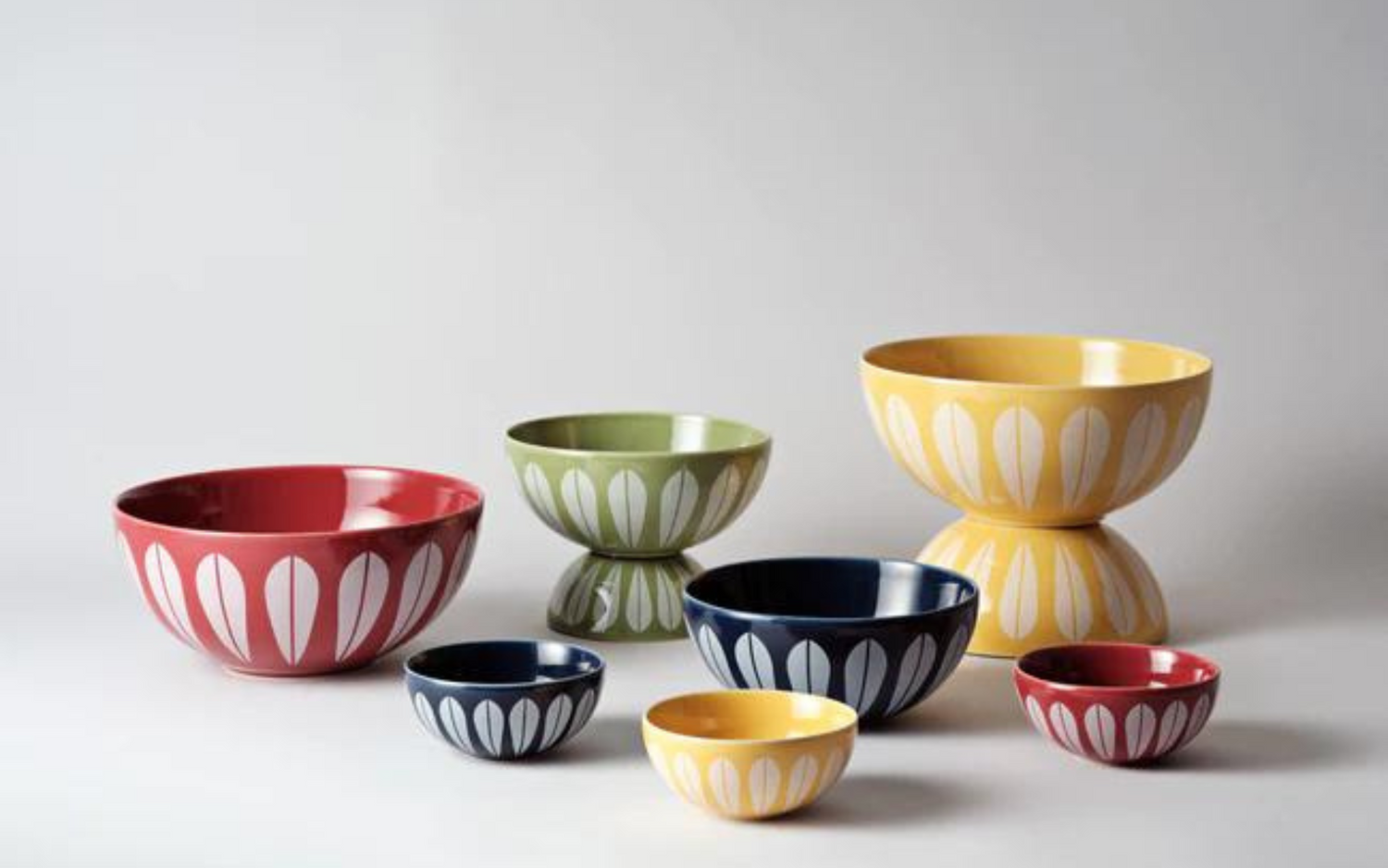The story
The story of the Arne Clausen Collection must begin with an understanding the artist behind the name, Arne Clausen (1923 – 1977) - a notable Norwegian figure whose life unfolded in Tistedal, a small community nestled by the river Tista on the outskirts of Halden, Norway. This locale played a pivotal role in shaping Halden's industrial landscape over the years.
In the post-World War II era, Arne Clausen found himself immersed in the world of ceramics within a local workshop. While one could delve into his wartime experiences with The Scottish Brigade, it was during his tenure at the ceramics workshop that Clausen's innate creativity blossomed, earning him recognition as a remarkably talented individual among his peers.
Transitioning to the next phase of his life, Arne Clausen settled with his small family near the river Tista. This proximity led him to the enameling factory Cathrineholm, strategically situated almost within the waterfall of Tista on an islet. Consequently, Clausen became actively involved with Cathrineholm A/S, a company primarily focused on crafting iron household articles with enamel coatings. In the post-war period, adapting to modern times, the factory shifted its production towards a lighter aesthetic—stainless steel adorned with transparent enamel. This transformation ushered in a new era requiring fresh expertise, artistic experimentation, and innovative design perspectives.
As an artist, Clausen emerged as a central figure in the Halden Art Society during the 1960s and 70s. His dedication to "making art visible" to the public showcased his passion for art's accessibility. Described as a versatile and creative artist, Clausen identified as a nature poet, delving into studies of humanity and societal satire. His artistic endeavors extended across various mediums, including visual art, illustration, enameling, and design. Notably, Clausen's work reflected a profound social engagement, marking him as an artist committed to exploring and expressing the complexities of human existence.

1950
Arne Clausen employed as inhouse decorator for Cathrineholm A/S
Even with a history that stretches back to the 19th century, it was only after the war that Cathrineholm started with innovative design. Arne Clausen and his colleagues had the difficult task of producing practical and decorative objects in enamel and steel. Clausen was fascinated by enamel and spent a lot of time experimenting with different methods of adding new dimensions to the product.

1957
Gold medal at Triennale di Milano
Together with Grete Prytz Kittelsen and Arne Korsmo, Arne Clausen wins the gold medal at the Triennale di Milano for their enamel works.

1964
Arne Clausen makes the first sketches of the iconic Lotus pattern
Cathrineholm was to launch a series of enamel bowls designed by Grete Prytz Kittelsen. However, they felt that the bowls were not commercial enough in themselves, and needed something more. It was in this connection that Arne Clausen introduced them to the Lotus pattern, which he had been sitting at home designing in his spare time.

1965
Lotus – a Norwegian icon is born
The first Lotus product landed on store shelves in 1965, and was an immediate sales success. The design hit a nerve both at the time and with housewives around the world, thanks to the simple, graphic pattern and color palette. It is unknown how many different varieties of Lotus exist. There is a minimum of 20, but there can also be more. In addition to the popular bowls, the Lotus pattern was also used on pots, frying pans, fondue pots, kettles and the popular "Sensation caserole". The popularity of Lotus meant that this pattern was also used on collections other than just the factory's own - the Danish Lyngby Porcelæn Fabrik also used the pattern on a number of their own commissioned porcelain products in the 1960s.

1970
Cathrineholm A/S is closed down, and the designer behind Lotus remains unknown
Although Lotus remained Cathrineholm's bestseller until the doors closed in 1970, Arne Clausen's contribution was never highlighted. Although Grete Prytz Kittelsen was behind the shape of the products, it was not she who designed the pattern that led to the great, worldwide success. In fact, it is documented that Kittelsen did not even like the Lotus pattern and felt that it took the focus away from her own design.

1977
The unknown designer passes away
After Cathrineholm closed down, Arne Clausen opened a small jewelery workshop where he made jewelery in copper and enamel. His extensive knowledge and experience with this material led to several consulting jobs for various Danish and Swedish companies. AC had always dreamed of visiting southern countries to experience their cultural richness. However, this dream came to a definitive end on the way back from a study trip to Italy. On 15 March 1977, Arne Clausen died suddenly of a heart attack at the Copenhagen Central Station. His contribution to Scandinavian design remained unknown for the next 35 years.

2000
Original Lotus products become collectors' items
Many Lotus products were now to be found at flea markets, auctions and antique shops. Demand and popularity were high, and the price of original Lotus products rose rapidly. A product that had cost NOK 300 could increase to close to NOK 1,000 within just two years. Today, depending on the product and wear and tear, an original Lotus product can cost anywhere from NOK 100 to NOK 5,000. The pink Lotus pattern is considered the rarest, and it is rumored that only 3,000 examples were produced in its time, and only for the American market.

2008
Østfold museum in Halden starts the hunt for an answer to the Lotus mystery
Despite Lotus' great success, Arne Clausen's name remained one of the best-kept secrets of 20th-century Scandinavian design. “Do you know who designed the Lotus pattern?” It took a newspaper whistleblower from Østfold Museum in Halden to uncover the truth. The ad led the team from the museum to Arne Clausen's children, who were able to show the museum evidence of their father's work, as well as original sketches. This drawing from 1964 is one of the first sketches of the Lotus pattern by Arne Clausen. Although the design is simple, it was a detailed process that led to the final result. As described by his daughter, Mette Marie Clausen: "I remember him at home, he would sit and cut and glue lotus icons in different sizes and materials to create the pattern, he tried out different spaces between the curves and was very precise in his work."

2010
Lucie Kaas gathers the threads
It only took one dinner party before the fascination was a fact. A salad served in an original Lotus bowl caught the attention of creative director and founder of Lucie Kaas, Esben Gravlev Rasmussen. Although the museum in Halden had uncovered the secret, Arne Clausen's role at Cathrineholm was the same unknown to most people. The question "Do you know who designed Lotus" was now asked by a small, unestablished company in Denmark.

2011
Esben Gravlev Rasmussen contacts The Norwegian Embassy in Copenhagen
Digital research and books about Cathrineholm gave no clear answers as to who was the originator behind Lotus. The Norwegian embassy referred Esben to the National Museum in Oslo, as they had the largest collection of information about Cathrineholm and Norwegian design. Nor could they immediately help. But after a few months they put Esben in touch with Østfold Museum in Halden. In the summer of 2011, Esben Gravlev Rasmussen meets Arne Clausen's children in Oslo.

2012
The Arne Clausen Collection is launched at Formland in Herning, Denmark
A small collection of bowls in four sizes and five colors were introduced. It was always Lucie Kaas' intention never to reproduce the original Lotus collection from Cathrineholm, but to celebrate the multiplicity of the Lotus pattern, and Arne Clausen as a forgotten contributor to the Scandinavian design scene. And therefore it was also a conscious choice not to use enamel, but ceramic for the bowls.

2013
The lotus fever is resurgent
The Arne Clausen Collection is quickly becoming popular, and the collection is being expanded to include new colors on the bowls, including mint green and coral. Since the Arne Clausen Collection was not only intended as a reintroduction of a design icon, but also an acknowledgment of Arne Clausen, Lucie Kaas believed that it was in the spirit of the collection to give opportunities to young Norwegian designers. In this connection, young Sara Skotte was hired to make a coffee set consisting of a coffee cup, sugar bowl and cream jug in the iconic Lotus pattern.

2015
Celebrating 50 years with Arne Clausen's Lotus
To mark that it was more than fifty years since Lotus was first launched in 1965, Lucie Kaas launched a collection of porcelain tableware. All the parts produced in 2015 bear the 50th anniversary logo.

2017
A break from the traditional
This season, Lucie Kaas takes the step further to show the diversity of the Lotus pattern, and has divided the collection into two:
Arne Clausen – Classic
In line with the original collection from both 1965 and 2012 – was
the manufactured Lotus pattern in white on colored substrate and colored Lotus pattern on a white background.
Arne Clausen – Trends
Tone on tone Lotus pattern in the colors of the season, developed for the modern home. The colors are strong, the Lotus pattern more discreet. A collection that really takes Lotus into a modern context, in combinations that have never been done before.

2023
Lotus of tomorrow
After 10 years, Lucie Kaas is giving the space needed for the Arne Clausen collection to grow and stand on its own. As of August 2023, the Arne Clausen Collection will exist in its own universe as a separate brand from Lucie Kaas. The new brand, ‘Arne Clausen Collection’ will still be part of the Lucie Kaas family, though independent with its own website and logo.
